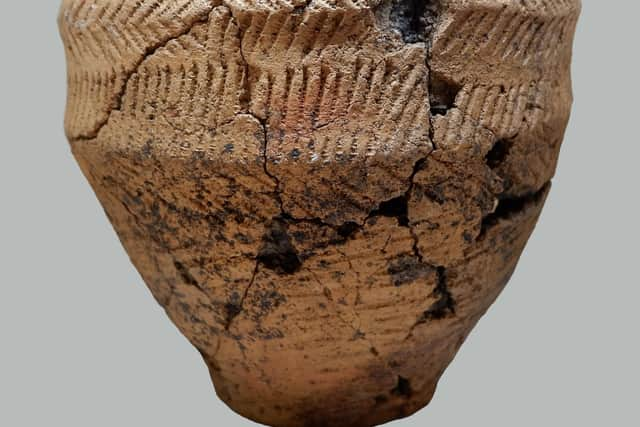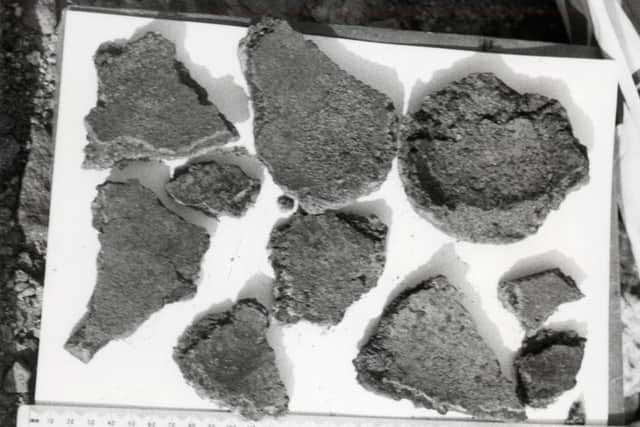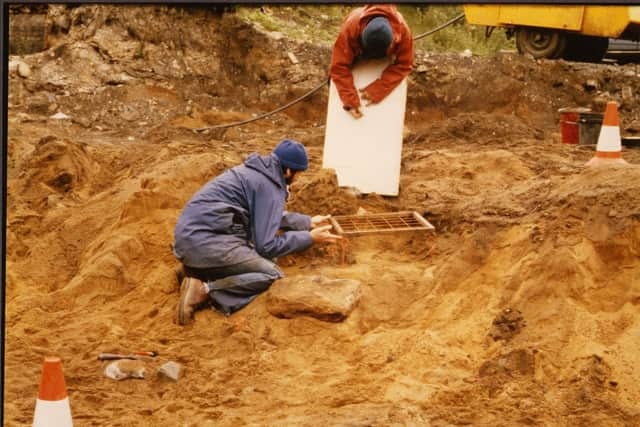5000-year old Bronze Age pot found in Kirkcaldy goes on display in town
and live on Freeview channel 276
The 5000-year-old container, discovered behind a butcher’s shop, is being exhibited at Kirkcaldy Galleries having been recently conserved by experts.
Conservation has been completed as part of a wider project to find out more about the human remains and objects found on Kirkcaldy High Street in June 1980.
Advertisement
Hide AdAdvertisement
Hide AdArchaeologists from the University of Glasgow, who are leading the study, will use a range of scientific techniques not available to their predecessors who carried out the dig.


Work to flatten the shop and a hotel 42 years ago was dramatically halted when a bulldozer driver caught sight of some partially buried bones.
Three burial cists – or ancient coffins – emerged in the subsequent dig. Two held human remains that showed traces of burning and the other contained the vessel, a flint arrowhead and a flint knife.
The find is one of several 5,000-year-old discoveries to have been made in Kirkcaldy, suggesting that the area was an Early Bronze Age stronghold.
Advertisement
Hide AdAdvertisement
Hide AdThe patterned clay vessel, which is 165mm in diameter and 160mm high, was found in several pieces and reconstructed by University of Glasgow archaeologists at the time.


All of the finds were added to the collection at Kirkcaldy Galleries where they have been cared for by curators ever since.
Curators recently noticed the vessel had become unstable and, following analysis by the Glasgow archaeology team, conservation work began, funded by Friends of Kirkcaldy Galleries.
Specialists at the Scottish Conservation Studio in Edinburgh have preserved and safeguarded the vessel using a reversible adhesive that allows the pot to be dismantled again, if need be.
Advertisement
Hide AdAdvertisement
Hide Ad

The pot has been partially filled as only 75 per cent of the original vessel survives. The filled material was then painted a different shade to the original pot so visitors can tell where additions have been made.
A grant from the Historic Environment Support Fund means post-excavation analysis of the other objects found at the site, as well as the human remains, can now go ahead.
Following an initial appraisal in April, the artefacts have been transferred to a laboratory at the University of Glasgow where analysis will take place.
The study is one of several being undertaken by University of Glasgow archaeologists that will bring to a conclusion uncompleted projects begun by their predecessors
Advertisement
Hide AdAdvertisement
Hide AdJane Freel, a curator with the cultural charity OnFife, which manages the Kirkcaldy collections on behalf of Fife Council, says: “We’re thrilled that visitors can now see this magnificent object for themselves as it offers a fascinating glimpse into Kirkcaldy’s distant past.”
Dr Marta Innes, who is part of the University of Glasgow archaeology team, says: “It’s a rare privilege to re-analyse an ancient object so many years after its discovery. We’re hopeful this will help us better understand the prehistoric life of the local area.”
Says Jane Freel “We are so grateful to the Friends of Kirkcaldy Galleries for funding the conservation of the food vessel so it can now be enjoyed by visitors to the Galleries.”
A pop-up photographic exhibition is being held at 243 High Street – the site of the burial – until September 30 to coincide with Scottish Archaeology month.
